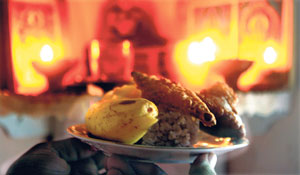
It’s OUR New YearThe call of the koha during the Maha season, the country’s most important rice harvest, is a reminder that the National New Year is around the corner. Another New Year sign is the flowering of the beautiful erabadu. When nature starts sending out these signals, people know it is time to start preparing for the festive celebrations, which are enjoyed on a grand scale all over the country.
Sri Lanka is a meeting point for four world religions, Buddhism, Hinduism, Christianity and Islam; most of the festivals we celebrate are associated with religion. However, our most widely celebrated festival is the National New Year, which is not confined to any particular religion. New Year observances are timed to match astrological signs. The rituals begin with the observance of nonagathe, when people stop all work and visit the temple for religious observances. The festivities start with the lighting of the hearth at the auspicious time. The whole family is clad in new clothes in the auspicious colour; this year the colours are red and yellow. The family members partake of their first meal in the New Year together, also at an auspicious time, after which it is time to exchange gifts. The celebrations embrace the community. In the villages, traditional games are enjoyed by all. The womenfolk take part in indoor games or play the raban. The festivities last for several days, and during this time families visit relatives and friends bearing gifts and sweetmeats. The festivities conclude with an anointing ceremony, in which an elder anoints the young with oil and invokes blessings. There are also auspicious times to go to work and look out for the new moon. The Sinhalese have celebrated the New Year for centuries. In his account of his years in the island as a prisoner of the King of Kandy, the English sea captain Robert Knox (1641-1720) described the New Year as a major festival, celebrated in March. New Year festivities similar to our own are celebrated around this time of year in Iran, India, Myanmar, Thailand, China, Taiwan and Japan. In the past, the New Year was celebrated largely by the Buddhists and the Hindus of our country. Now Christians too participate in the celebrations. In recent times, the occasion has become more of a national festival. The New Year is not strictly a Buddhist festival, although Buddhists go to the temple at the nonagathe time. The major Buddhist festivals in Sri Lanka are Vesak, Poson and Esala. Buddhist rituals are observed on Poya days, based on the lunar calendar. In astrological terms, the New Year is a solar festival that starts with the entry of the Sun in the zodiac into the house of Aries. The New Year cannot be categorised as a Hindu festival either. While it is celebrated by Tamils and other communities in South India, such as the Andhras, Kannadigas and Malayalis, the Hindus in North India and the Himalayan region have their own dates for the New Year. When the Holiday Bill came up for debate in the Legislative Council of 1886, one council member proposed making the New Year a holiday for the Hindus, because Vesak had been declared a holiday for the Buddhists, according to the historian Dr. Suriya Gunasekera. The proposal was not adopted, but the holiday was erroneously gazetted as the “Sinhala and Hindu New Year”, and it has been so described ever since. There is a general consensus among all communities in Sri Lanka to treat the New Year as a national festival, combining Buddhist and Hindu religious elements. Because the New Year is not a religious festival, restricted to any particular faith, it may be considered a national festival to be enjoyed by all Sri Lankans. The New Year comes at a time that is ideal for celebrating a national festival. The rains have arrived after a spell of hot, dry weather, and there is greenery everywhere. Birds sing, flowers bloom, and vegetables and fruits are in abundance. The harvest is over and people are free to celebrate. This is also a time for wedding celebrations in the villages. |
|
||||||
|| Front
Page | News | Editorial | Columns | Sports | Plus | Financial
Times | International | Mirror | TV
Times | Funday
Times || |
| |
Reproduction of articles permitted when used without any alterations to contents and a link to the source page.
|
© Copyright
2008 | Wijeya
Newspapers Ltd.Colombo. Sri Lanka. All Rights Reserved. |
